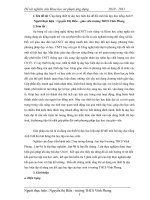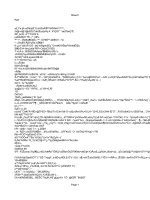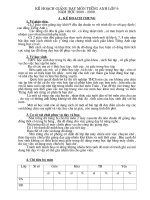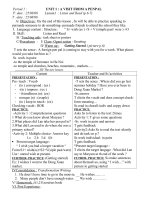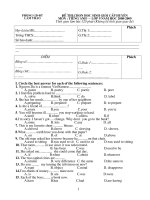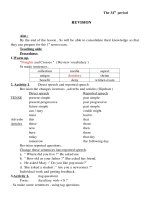Tieng Anh 9 - U2-Read
Bạn đang xem bản rút gọn của tài liệu. Xem và tải ngay bản đầy đủ của tài liệu tại đây (760.37 KB, 25 trang )
Unit 2: CLOTHING - LESSON 4: Read (Page 17)
I. VOCABULARY:
Unit 2: CLOTHING - LESSON 4: Read (Page 17)
I. VOCABULARY:
- Cotton (N): Cây bông, sợi bông
- Wear out (V):
Sờn, mòn
Unit 2: CLOTHING - LESSON 4: Read (Page 17)
- Style (N)
Kiểu dáng
Unit 2: CLOTHING - LESSON 4: Read (Page 17)
- Embroider (V): Thêu
Unit 2: CLOTHING - LESSON 4: Read (Page 17)
I. VOCABULARY:
- Cotton (N): Vải bông, sợi bông
- Wear out (V):
Sờn, mòn
- Style (N):
Kiểu dáng
- Embroider (V): Thêu
Lỗi mốt- Out of fashion:
Unit 2: CLOTHING - LESSON 4: Read (Page 17)
I. VOCABULARY:
Matching
A B
1. Cotton a. Lỗi mốt.
2.Wear out b. Thêu
3. Out of fashion c. Sờn, mòn
4. Embroider d. Kiểu dáng
5. Style e. cây bông, sợi bông
I. VOCABULARY:
II. FILL IN THE MISSING DATES AND WORDS:
DATES EVENTS
1..........................
Workers liked to wear ........................ because
the material made from cotton was very strong
and could hardly wear out.
2. ........................
A lot of university and colleage students wore
jeans
3. ........................
Jeans became .................. so many, many people
began wearing jean.
4. ........................ Jeans became high ................... clothing.
5. ........................ The sales of jeans stopped going up.
1970s
fashion
18
th
century
Jean cloth
Unit 2: CLOTHING - LESSON 4: Read (Page 17)
1960s
cheaper
1980s
1990s
I. VOCABULARY:
II. FILL IN THE MISSING DATES AND WORDS:
Unit 2: CLOTHING - LESSON 4: Read (Page 17)
III. ANSWER THE QUESTIONS:
1. Where does the word Jeans come from?
4. When did jeans at last become high fashion
clothing?
5. Why did the sale of jeans stop growing?
2. What was the 1960s
/
fashions?
3. Why did more and more people begin wearing
jeans in the 1970s?

